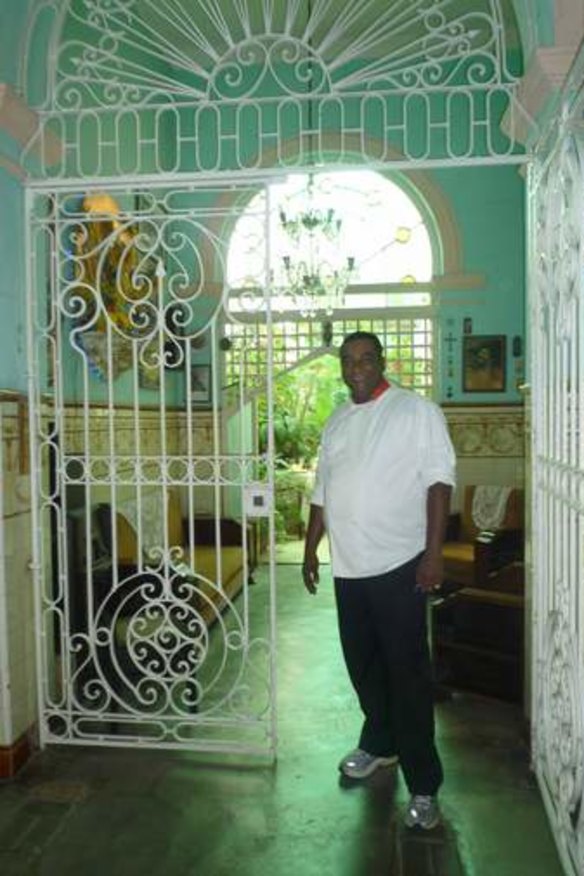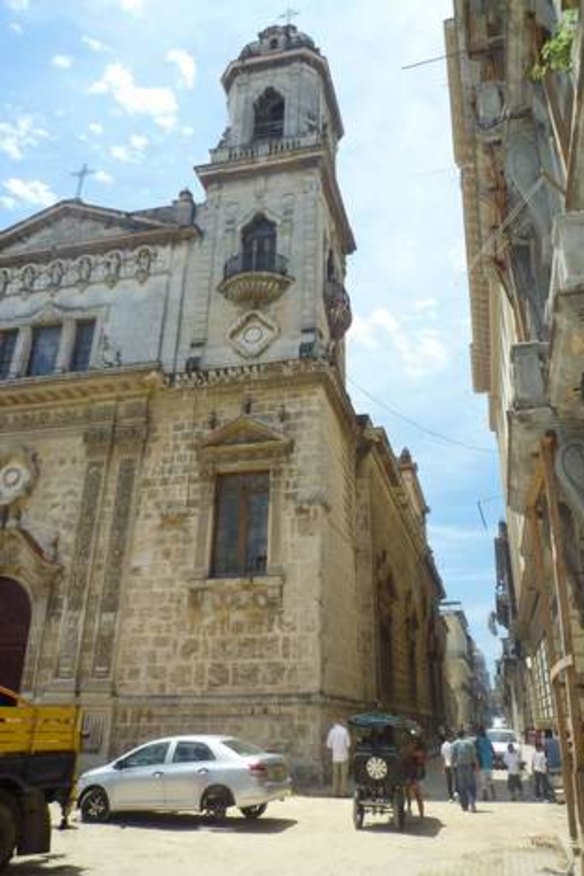Cuisine a match made in Havana
Cuba is moving in fits and starts towards modern dining, Francesca Beddie finds.

A friend who knows Havana well told us not to eat in a state-run restaurant while we were there. We did; to the uninitiated, hot and thirsty tourist they beckon. Some are good; all expensive. The government restaurants in the old part of the city belong to the Habaguanex tourist company set up in 1994 to contribute funds to the rebuilding of the old city. They must hire people who live in the precinct, a measure designed to encourage a sense of community as the crumbling infrastructure is returned to its former glory.
Our friend had told us to eat at the paladares. These are privately run eateries, named after a restaurant called Paladar (palate) in a long-running Brazilian soap opera. They are emerging with such rapidity it's hard for anyone to know what's the best on offer.
TripAdvisor names Dona Eutimia as No. 1, so that's the first we try. It's a tiny establishment tucked into the end of small street in the warren of the old city, only easy to find if you know where to look. A tout at the intersection of Plaza de la Cathedral and Collejon del Chorro banks on you not knowing. He leads you to his own place, right next door, but clearly without the same appeal.

We arrive before dark (very early to dine in Cuba), but already there are no seats inside. Outside is pleasant when the breeze comes up and the repertoire of this restaurant's minstrels is broader than most. The waiters are solicitous; one speaks good English and explains the menu: simple Cuban fare.
We order shredded lamb and grilled chicken, both of which come with standard sides: white rice, black beans, banana chips and salad. The house wine is Chilean. The meal is tasty, satisfying and very reasonably priced ($28 for two mains and a couple of glasses of wine each).
The next night we follow the advice of the Lonely Planet guide and go upmarket. We book a table at the Cafe del Oriente for 8pm. Beforehand, we wander to the heart of the restored city, the Plaza Vieja, where Havana's new boutique brewery serves a malty beer.
The Cafe del Oriente opened in 1994. Cuba was starting to cater to tourists as a way of coping with the economic shock of the "Special Period", caused by the collapse of the Soviet Union and the loss of a captive market for Cuban sugar exports. Overnight in 1991, life in Cuba changed: no petrol and, until the Chinese donated bicycles, no transport; blackouts and hardship. For many living in the old city those deprivations are yet to be surmounted.
Tourism has been rising steadily. In 1993, Cuba received 546,000 foreign visitors; in 2012 it was 2.84 million. And that's without access to the American market, still closed except for some educational tourism because of the US embargo on trade with Cuba.
In a restored bank building on one of the most charming squares of the old city, we are greeted by the restaurant's waiters, donned in the evening attire of their professions. (The one waitress wears a too-short skirt and a too-tight vest.) We are presented with an appetiser of guacamole and hummus, with freshly pureed avocados. Our bottle of 2009 French cabernet sauvignon is decanted.
The lobster and shrimp bisque has the right flavours but they are thin. The tuna ceviche is made with tinned rather than fresh tuna. Decorative salsas and gels have been swirled around the circumference of the delicate plate.
The mains arrive on bold black shiny platters. The fish stew – lobster, mussels, shrimp and fish in a sweetish tomato and onion sauce – is delicious. The snapper stuffed with salmon – the latter the dominant taste – is a tad overcooked. Both come with potato and a compote of vegetables. In the end, it's more about style than taste. Would that have been the case with the lamb cooked in chocolate and rosemary?
It's 9pm, announced to the people of Havana with a single cannon shot, a tradition hailing from the days when the city was closed off for the night, but for today's Cubans a reminder of their childhood bedtime. We eschew dessert. Among the offerings are a bombe Alaska and a cheesecake with guava cream and gin and tonic frappe.
As we await the bill, one of the waiters, who has been rearranging the vase of gladioli, presents me with a single stalk. It is a charming gesture from someone oblivious of Dame Edna's penchant for this bloom.
It feels like the end of the season – visitors to Cuba (the majority come from Canada) are already on their way home for the beginning of the school year. But the price, too, might explain the lack of diners. Our meal cost about $120 for two.
The following day, we go in search of another paladar on the TripAdvisor list. San Cristobal Paladar is in central Havana, beyond the precinct of the old city on a thoroughfare that takes you through a bustling shopping district into more blocks of run-down apartments and dingy rooms selling Cuban CDs or hunks of unrefrigerated meat. Havana's famous 1950s cars the curb. Among the seediness stands an emerald-green house, built in the first decade of the 20th century.
It's a welcome sight if you've walked for an hour in the midday heat. The stress shows on our faces; we are immediately invited inside to an airconditioned room, full of 1950s and '60s bric-a-brac. We are seated at a small square table. Most of this room is taken up with a horseshoe arrangement. On one wall is a saint, Cristobal presumably, shrouded in satin. On others are a collection of old clocks, black and white photos of the celebrities who visited Havana in its 20th-century heyday and an arrangement of old record covers.
A tall man with a sparkling smile is putting out name cards for a birthday party this evening. He turns out to be Carlos Cristobal Marquez, owner and chef of the San Cristobal Paladar. He gives us a hearty welcome in Spanish.
Our waiters translate and explain. Marquez entirely renovated the house. Some rooms are for private dining – the Spanish ambassador entertained in one last night. The original bathroom has been scrubbed of decades of grime and decorated with peacock feathers and posters. Outside is a patio with more tables and chairs.
We relax with local beer and sangria, not too sweet. We've been persuaded to have a plate of starters. There's (overly) pickled lobster and squid; salmon with a scattering of roe; various cheeses; tiny fried vegetable balls; olives; and an aubergine ceviche.
As we eat we learn more about the restaurant. One of the waiters, William, has been to Spain and to Miami, a rare adventure for Cubans. He can travel. His grandparents swapped Franco's Spain for Havana and bequeathed him a European Union passport. The youngest of the waiters, who looks younger than his 23 years, explains that when he chose to do hospitality, he never dreamt he might work in an establishment like San Cristobal Paladar. Even a couple of years ago the only career path was with state-owned eateries.
In our wanderings through old Havana we've seen no antique shops, so we wonder where all the memorabilia comes from. William explains that people now come to the house offering items for sale. Later, coffee is served in delicate demitasses that hail from a very different era of dining.
My grilled angelfish, decorated with starfruit and avocado, is the best dish I've eaten in Havana. The other main is a tender lamb stew in a rich molasses sauce. Both are with creamy mashed potato, as well as the ubiquitous Cuban rice and black beans. Here, they retain their shape and crunch, taking a step up from a well-cooked national dish to something more sophisticated and modern.
We share the signature dessert, the San Cristobal pudding – more like a cake – with sugary topping and a brushing of a sticky preserve.
When we ask for the bill ($47) we are persuaded to stay a little longer. In liqueur glasses, the more delicate one for me, comes Havana Club rum, as good as many a brandy. A gift of a cigar is offered but not insisted upon. I receive a tiny brooch, a memento of that most luxurious of meals, the long lunch, and a signal of hope for a renewed Havana.
The city historian, Eusebio Leal Spengler, has done a magnificent job getting Havana on to UNESCO's World Heritage list and in overseeing a restoration that will go well beyond its facades. And the loosening up of the economy is bringing a new vitality to city, led by the paladares. While there's still a way to go before Havana's renaissance means Cubans or visitors will be able to savour haute cuisine, there's always solace in another daiquiri.
Francesca Beddie is a historian, editor and reviewer, who lives on a bush block outside Queanbeyan. She visited Cuba at her own expense.